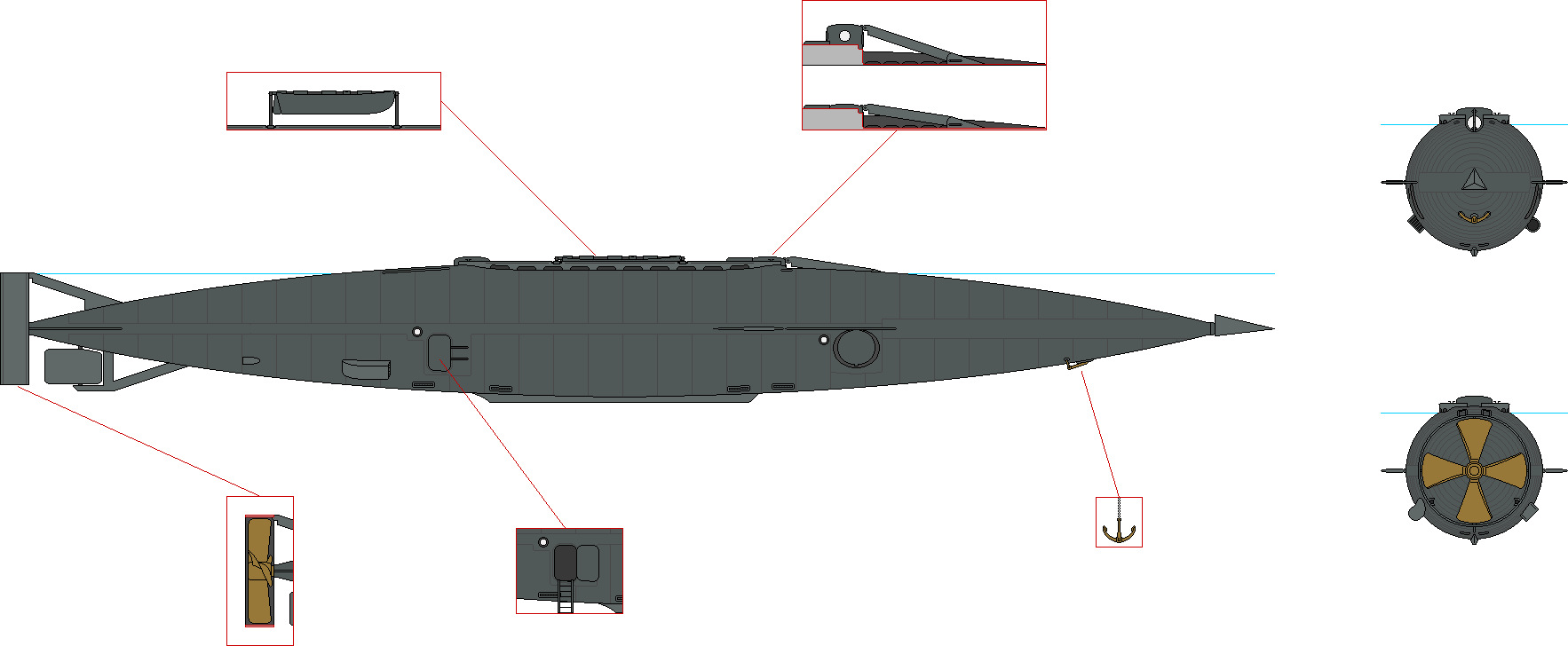|
|
y intent in this design was to remain reasonably faithful to Verneís description, while acknowledging some practical concerns. These concerns mostly relate to the Nautilusís ability to withstand damage during its ram attacks. As Paul Kreutzer noted, ramming a ship will incur damage to both attacker and target. Most of my |
|
departures from the text are intended to protect vulnerable components from the shock of impact. There are also a number of embellishments not described in the novel, but whose presence might be inferred from the necessities of operating a submarine (though Iím not an engineer). Of course, aesthetic judgments play a role in any design decision. I ultimately wanted something that would be recognizable both as the Nautilus of the book and as a product of 19th-century technology. Like many others, I turned to the Hunley and Winans reconstructions for inspiration. The results are illustrated in the included figures. On to the tour!
The hull is
spindle-shaped and of the dimensions given by Verne. The hull shape makes
for a cramped interior, but is consistent with the illustrations and still
fits the major rooms. The double hull is 30 centimeters thick. The hull
plating, rather than the overlapping scales that Verne described, are of a
conventional riveted plate construction. This arrangement would be easier to
fabricate and possibly easier to repair (not to mention easier to draw!)
| |
|
The salon window is
one of the most distinctive features on any Nautilus design. In this
case, it is recessed into the hull and features a spotlight, as in several
other designs. A metal cover slides vertically between the outer and inner
hulls to cover the window. I decided to depart from the oblong window of the
novel in favor of a circular one. As Jim Dutton pointed out, a circular
window is stronger than an oval or rectangular one Ė certainly a
worthwhile choice for a ship intended as a weapon. I briefly considered a
three-part window, in which a circular frame is flanked by two
crescent-shaped ones for an overall oval profile (see right). I eventually decided against this shape, but found its appearance intriguing
enough to be worth mentioning. | 
|
|
There are good
arguments against a propeller guard, but I consider its presence vital. This
guard is secured by three fairings, one on the top of the hull and one on
either side. The propeller is four-bladed and based on that of USS Monitor.
I imagine the propulsion system to be similar to the compact steam engine
found on Monitor, but with electromagnets driving the pistons within
the cylinders. The hull features port and starboard coolant water intakes
just ahead of the engine compartment. The starboard intake is behind the
lockout chamber (itself fitted with a spotlight,) and features a grille in
order to prevent any unfortunate diver-ingestion incidents.
The platform and deck have the major features in the conventional layout, with two hatches. Retractable bollards and fixed cleats are a minor but useful change from the text. Forward of the platform is a wide groove cut into the upper hull Ė more on this later! Ė which is flanked by two openings for the waterspouts described in the novel. Aft of the platform are paired grilles for air intakes (providing a faster way to refill the air reservoir than simply opening the hatches.) The longboat sits in
the center of the deck. It is launched using the elegant rotating-frame
arrangement proposed on this website. The longboat is held in its frame by
two bolts, one on the prow and one above the rudder, and can rotate freely
so that it remains upright during the entire launch sequence. I was quite
pleased with my innovation until I saw that Greg Merkle had already
described the exact same refinement to the system. Oh well, the setup is
just too practical to ignore. My largest departure
from Verne is the use of cylindrical, not rectangular, shapes for the
wheelhouse and lantern. Subject to an external force, a boxlike shape will
concentrate stress along its edges and may be vulnerable to failure. A
cylinder would absorb force more evenly and would be stronger for a given
size. Both structures have four ports on their sides, the lanternís being
offset by 45 degrees to prevent light shining directly into the wheelhouse.
The lantern also has a fifth port on top, which is closed by internal
shutters during normal operation and opened when the lantern retracts. The wheelhouse
itself is an opportunity to really make a distinctive design. It stands at
the end of the groove cut into the upper hull. Immediately aft of it is a
low structure containing the forward hatch, which descends directly into the
chart room. A single cutwater, inspired by the Hunley, extends
forward from the wheelhouse into the hull groove in order to protect the
forward viewport. Giving the cutwater an archlike profile granted the happy
accident of evoking Goffís raker arch. Among the suggested
solutions to the retraction problem was one offered by Don Finnerty: a
groove in the upper part of the hull, which would allow some visibility for
the helmsman when the Nautilus makes its attack. Oddly, no designs in
the catalog have used this solution. The groove here is large enough that no
part of the forward viewport will be obscured when the wheelhouse is
retracted. Hinges on either end of the cutwater allow it to move with the
wheelhouse. In its lowered position, the cutwater no longer projects above
the hull, while not compromising protection to the vulnerable window. Itís
the most unique part of this design, and the feature that Iím most proud
of. The result of all
this is a Nautilus which to me appears sturdy, yet graceful, and
keeps to the spirit of Verneís text. To me, the truly fascinating thing
about this website is how it has become a venue for creative people to come
together and debate the aspects of an icon of science fiction. The many,
many designs exhibited here have each demonstrated great inventiveness and
provoked rewarding thought. I would like in particular to thank Paul
Kreutzer and Greg Merkle for their thoughtful analyses, and Michael
Crisafulli for forming this community of creators. And of course, I wish to
thank Jules Verne, for inspiring all of us.
| |

